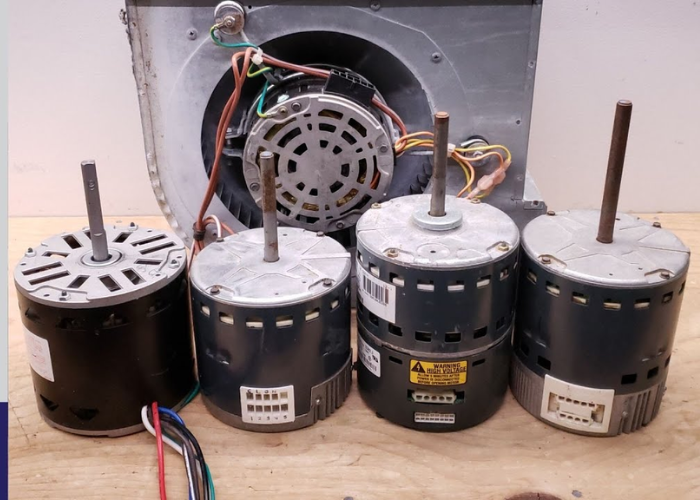Welcome to the world of heating systems! Imagine those chilly winter mornings waking up to a warm and cozy home, thanks to the trusty furnace. Have you ever wondered how the warmth is evenly distributed throughout the living space? Well, that’s where furnace blower motors come into play. This article will take you through the components and operation of a furnace blower motor, exploring its vital role in the heating process. So, get ready to dive into the heart of your heating system!
The Power Behind the Warmth
The furnace comes to life when the thermostat is set to a comfortable temperature. But have you ever thought about how the warm air travels from the furnace to every corner of the home? It is where these blower motors step in. Think of it as the engine of the heating system. It’s responsible for circulating the heated air produced by the furnace, ensuring each room receives equal warmth. Without this crucial component, the furnace’s efforts would be confined, leaving some areas colder.
Anatomy of a Furnace Blower Motor
A closer look at the inner workings of these furnace blower motors reveals several vital components working harmoniously. The heart of the motor is its rotor, connected to the fan blades. As the rotor spins, it propels the fan blades, creating a powerful airflow. Surrounding the rotor is the stator, a stationary set of coils that generate a magnetic field when electricity flows through them. This interaction between the rotor and stator converts electrical energy into mechanical motion, resulting in the rotation of the fan blades and the movement of air.
The Role of Capacitors
Capacitors play a significant role in the operation of furnace blower motors. These small, cylindrical devices store and release electrical energy to provide an extra boost when it starts. Think of them as a sprinter’s burst of energy at the beginning of a race. When the furnace is turned on, the capacitor releases a jolt of power, helping the motor overcome inertia and initiate rotation. Once it is up and running, it relies on the steady flow of electricity from the home’s electrical system. Capacitors contribute to the efficiency and reliability of the motor, ensuring it starts quickly and runs smoothly.
Speed Options – More Than Just High and Low
Furnace blower motors have various speed options, allowing airflow customization for optimal comfort. These speeds are usually labeled as high, medium, and low. Each speed setting serves a distinct purpose. High-speed suits quickly warm the home, especially during frigid weather. Medium speed balances efficiency and comfort, maintaining a consistent temperature without using excessive energy. Low speed is perfect for preserving warmth over an extended period without causing drastic temperature fluctuations. Whether in a hurry or aiming for steady heat, the furnace blower motor covers all needs.
The Importance of Maintenance
Just like any other mechanical component, furnace blower motors require regular maintenance to keep them performing at their best. The accumulation of dust and debris on the blades can cause imbalances, decreased efficiency, heightened energy consumption, and premature wear and tear. It is imperative to take action to prevent such consequences. Regularly cleaning the motor and its surroundings can go a long way in preserving its functionality. Additionally, scheduling annual professional inspections ensures that all components are in top-notch condition, preventing potential issues before they escalate.
Energy Efficiency and Your Home
In today’s world, energy efficiency is a priority. Furnace blower motors have evolved to meet this demand by incorporating advanced technologies. Variable-speed motors are a prime example of this innovation. Unlike traditional single-speed motors, these can adjust their speed according to the heating requirements. It not only provides consistent comfort but also reduces energy consumption. Imagine these motors acting like smart assistants, adapting to needs and conserving energy without compromising warmth.
Troubleshooting and When to Seek Help
Even with proper maintenance, furnace blower motors can encounter issues. If uneven heating, strange noises, or reduced airflow are noticed, it’s time to play detective. Check for obstructions around the motor and ensure the fan blades are clean. Sometimes, a faulty capacitor might be the culprit behind a slow start. However, if the issues persist, calling a professional technician is wise. These experts have the knowledge and tools to diagnose and repair complex motor problems, ensuring the heating system remains tip-top.
Conclusion
Furnace blower motors might seem like hidden heroes, quietly working behind the scenes to keep homes warm and comfortable. With knowledge of their components and operation, an appreciation for their role in heating system performance can be developed. From intricate anatomy to the importance of maintenance and energy efficiency, furnace blower motors are a testament to human ingenuity in creating systems that bring comfort to lives. So, the next time you are basking in the cozy embrace of home’s warmth, remember the unsung champion – the furnace blower motor.


